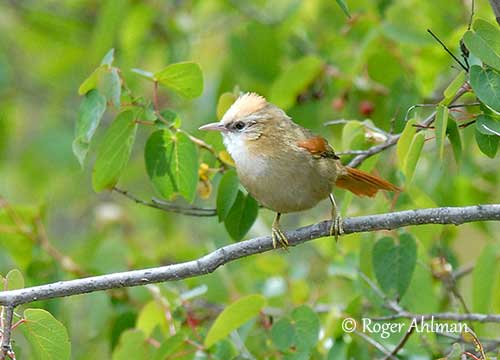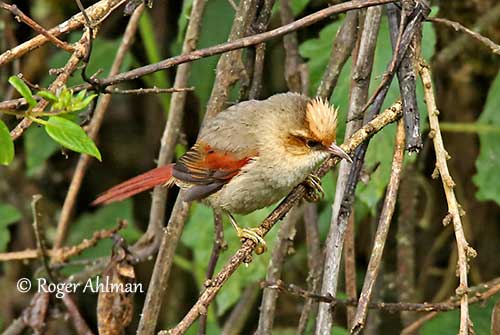
Fr: Synallaxe à calotte blanche
Ang: Creamy-crested Spinetail
All: Fahlkappen-Baumschlüpfer
Esp: Curutié Crestado
Ita: Codaspino crestacrema
Nd: Vaalkopstekelstaart
Sd: gräddkronad taggstjärt
Photographer:
Roger Ahlman
Pbase Galleries Peru and Ecuador
Text de Nicole Bouglouan
Sources:
HANDBOOK OF THE BIRDS OF THE WORLD Vol 8 By Josep del Hoyo-Andrew Elliott-David Christie - Lynx Edicions - ISBN: 8487334504
BIRDS OF SOUTH AMERICA – Passerines - by Robert S. Ridgely and Guy Tudor – HELM Field Guides – ISBN: 9781408113424
Neotropical Birds – Cornell Lab of Ornithology
A blog dedicated to the thousands of bird species that fly, swim or walk on our planet.
Foraging Ecology of High Andean Insectivorous Birds in Remnant Polylepis Forest Patches
Creamy-crested Spinetail
Cranioleuca albicapilla
Passeriformes Order – Furnariidae Family
INTRODUCTION:
The Creamy-crested Spinetail is endemic to Peru where it is relatively common in semi-arid montane scrub and woodland, often near streams and even in disturbed habitats.
It feeds primarily on arthropods by gleaning food items from the vegetation. It typically nests in a small globular structure suspended from the end of a branch, typical of members of the family Furnariidae.
The Creamy-crested Spinetail is not globally threatened because it is tolerant to degradation of the habitat and fragmentation of woodland.
DESCRIPTION OF THE BIRD:
Biometrics:
Length: 16-17 cm
Weight: 18-24 g
The Creamy-crested Spinetail has brownish-olive upperparts becoming browner towards the rump. On the upperwing, the rufous wing-coverts contrast strongly with the duller, dark brownish flight-feathers. The graduated tail is rufous, with sharply pointed rectrices.
On the underparts, throat and upper breast are white. The lower breast is mostly creamy-white whereas the belly is duller and grey-brown. Flanks and undertail-coverts may appear slightly browner.

On the head, the crown is creamy-white, with feathers often raised into a bushy crest. An irregular, narrow, greyish-brown stripe separates the whitish supercilium from the crown. The face is buffy-brown with dark streaks. The lores are dark grey-brown.
The bill is grey to pinkish. The eyes are chestnut to grey. Legs and feet are olive-yellow to greenish-yellow.
Male and female are similar.
The juvenile resembles adult but it has pale yellowish forehead and throat, variably tinged ochraceous underparts and sooty nape and upper belly.
SUBSPECIES AND RANGE:
The Creamy-crested Spinetail has two subspecies.
C.a. albicapilla (described above) occurs in the Andes of C Peru (Junín and Huancavelica and S to Ayacucho and Apurímac).
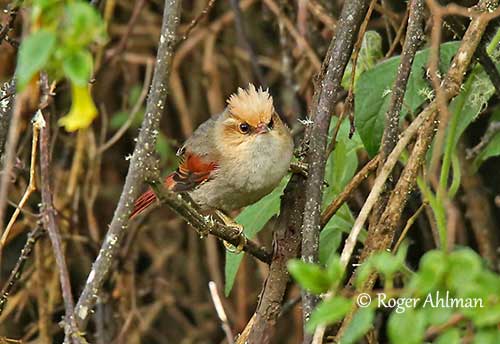
C.a. albigula is found in the Andes of S Peru (Cuzco to Ayacucho and Apurímac).
This race has more ochraceous rear crown, browner back, more fulvous rump and reddish-rufous uppertail-coverts, and strongly washed tawny-buff underparts contrasting with the white throat.
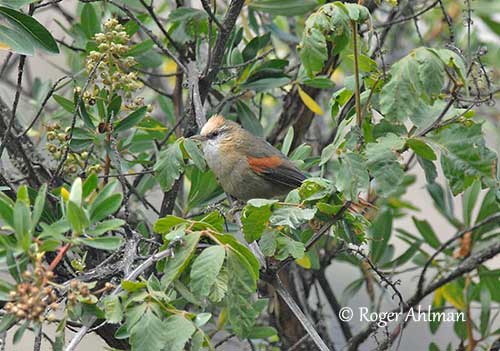
HABITAT:
The Creamy-crested Spinetail frequents dense, semi-arid woodland in mountains, scrub and patches of woodlands with mainly Polylepis trees in the Andes of S Peru, up to 2,500/3,600 metres of elevation. It frequently occurs near streams. It has adapted to patchy and disturbed habitat and even occurs in disturbed cultivated areas.
CALLS AND SONGS: SOUNDS BY XENO-CANTO
The Creamy-crested Spinetail gives a rising “tlee’lee” and also a loud, semi-whistled “dew”. We can also hear rapid series of repeated “tleep” notes.
The song is loud and frequently given. It is a descending series of semi musical notes “tch, tch, chee, chee, cheechee, ee-ee-ee-ee-ew”
BEHAVIOUR IN THE WILD:
The Creamy-crested Spinetail is an insect-eater and consumes a variety of arthropods.
It usually forages alone or in pairs, by walking, and then stopping along branches to probe into bark crevices, moss and epiphytes.
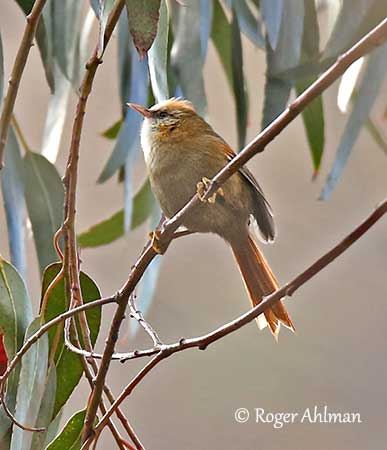
It often frequents Polylepis woodland patches that provide the birds an essential foraging habitat, well-adapted to insectivorous species.
The breeding behaviour of the Creamy-crested Spinetail is poorly known. The absence of sexual plumage dimorphism does not allow to determine the contributions by each sex. However, from observations of several species of Furnariidae, both mates probably share most of nesting duties.
We can also suggest that the erectile crown feathers, the bright-coloured parts of the plumage and the long, graduated tail are used during the courtship displays.
This species nests in a globular structure suspended at the end of a branch.
The Creamy-crested Spinetail is resident in its range.
It flies frequently between the foraging sites, but it does not perform long-distance flights.
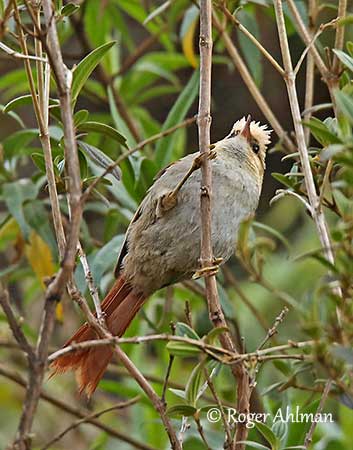
REPRODUCTION OF THIS SPECIES:
The breeding season possibly occurs from January to May, as fledglings were observed in May.
The Creamy-crested Spinetail builds a small globular nest of about 30 centimetres in diameter. It is made with moss, twigs and bark strips. This structure is usually suspended from the end of a branch. A hole at the bottom of the nest is used as entrance.
The chicks are probably fed on insects by both parents.
PROTECTION / THREATS / STATUS:
The Creamy-crested Spinetail has restricted range in which it is fairly common to common. It has adapted to fragmented or disturbed woodland and cultivated areas. However, the species is also present in protected areas.
The population is suspected to be stable, and the species is not globally threatened.
The Creamy-crested Spinetail is currently evaluated as Least Concern.
